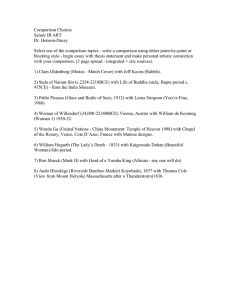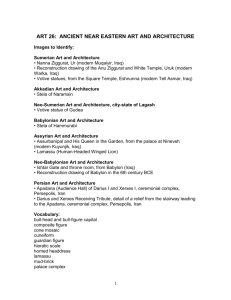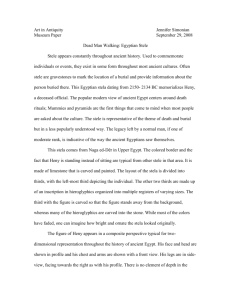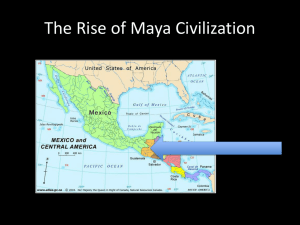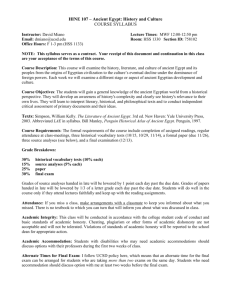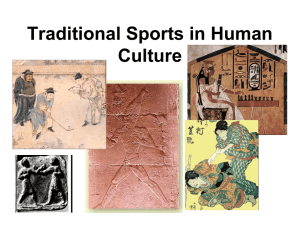As scholars devote their attention to
advertisement
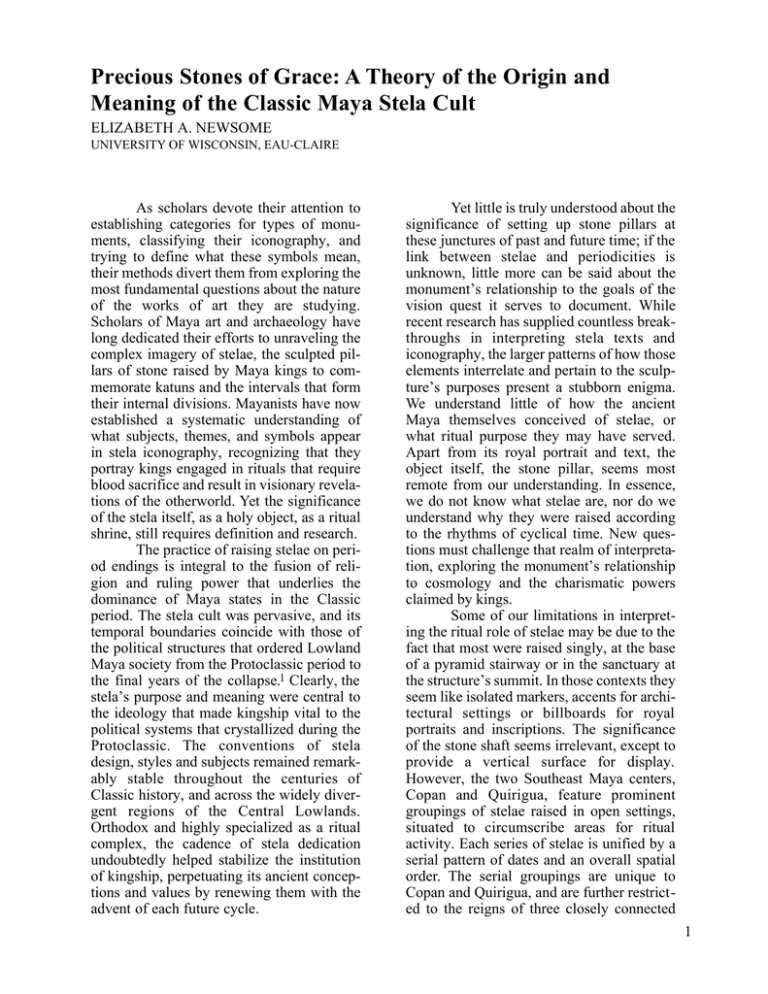
Precious Stones of Grace: A Theory of the Origin and Meaning of the Classic Maya Stela Cult ELIZABETH A. NEWSOME UNIVERSITY OF WISCONSIN, EAU-CLAIRE As scholars devote their attention to establishing categories for types of monuments, classifying their iconography, and trying to define what these symbols mean, their methods divert them from exploring the most fundamental questions about the nature of the works of art they are studying. Scholars of Maya art and archaeology have long dedicated their efforts to unraveling the complex imagery of stelae, the sculpted pillars of stone raised by Maya kings to commemorate katuns and the intervals that form their internal divisions. Mayanists have now established a systematic understanding of what subjects, themes, and symbols appear in stela iconography, recognizing that they portray kings engaged in rituals that require blood sacrifice and result in visionary revelations of the otherworld. Yet the significance of the stela itself, as a holy object, as a ritual shrine, still requires definition and research. The practice of raising stelae on period endings is integral to the fusion of religion and ruling power that underlies the dominance of Maya states in the Classic period. The stela cult was pervasive, and its temporal boundaries coincide with those of the political structures that ordered Lowland Maya society from the Protoclassic period to the final years of the collapse.l Clearly, the stela’s purpose and meaning were central to the ideology that made kingship vital to the political systems that crystallized during the Protoclassic. The conventions of stela design, styles and subjects remained remarkably stable throughout the centuries of Classic history, and across the widely divergent regions of the Central Lowlands. Orthodox and highly specialized as a ritual complex, the cadence of stela dedication undoubtedly helped stabilize the institution of kingship, perpetuating its ancient conceptions and values by renewing them with the advent of each future cycle. Yet little is truly understood about the significance of setting up stone pillars at these junctures of past and future time; if the link between stelae and periodicities is unknown, little more can be said about the monument’s relationship to the goals of the vision quest it serves to document. While recent research has supplied countless breakthroughs in interpreting stela texts and iconography, the larger patterns of how those elements interrelate and pertain to the sculpture’s purposes present a stubborn enigma. We understand little of how the ancient Maya themselves conceived of stelae, or what ritual purpose they may have served. Apart from its royal portrait and text, the object itself, the stone pillar, seems most remote from our understanding. In essence, we do not know what stelae are, nor do we understand why they were raised according to the rhythms of cyclical time. New questions must challenge that realm of interpretation, exploring the monument’s relationship to cosmology and the charismatic powers claimed by kings. Some of our limitations in interpreting the ritual role of stelae may be due to the fact that most were raised singly, at the base of a pyramid stairway or in the sanctuary at the structure’s summit. In those contexts they seem like isolated markers, accents for architectural settings or billboards for royal portraits and inscriptions. The significance of the stone shaft seems irrelevant, except to provide a vertical surface for display. However, the two Southeast Maya centers, Copan and Quirigua, feature prominent groupings of stelae raised in open settings, situated to circumscribe areas for ritual activity. Each series of stelae is unified by a serial pattern of dates and an overall spatial order. The serial groupings are unique to Copan and Quirigua, and are further restricted to the reigns of three closely connected 1 Fig. 1 Position of 18-Rabbit’s Stelae in the Great Plaza of Copan. After Webster 1986, figure 1. kings.2 Despite their limited distribution, I believe that analysis of the design, inscriptions and iconography of these stela cycles can aid in interpreting the stela cult at other sites, and in other contexts. The three programs were created by Smoke-Imix-God K, 12th ruler of Copan, his successor, 18-Rabbit-God K, and Butz’ Ti’wil, or Cauac Sky of Quirigua. The Smoke-Imix set chronicles a countdown of intervals leading to the katun ending 9.11.0.0.0 (October 11, 652 A.D.). The stelae seem designed to unify the outlying areas of the Copan Valley with the center of rule at the Main Group of ruins, for spatially and chronologically, they form a circuit of the valley’s perimeter that begins and ends with two sculptures at the Main Group. Four stelae located on hill slopes east and west of the principle ruins carry the sweep of the katun’s chronology to the boundaries of community space. 3 Butz’ Ti’wil’s series appropriates features of 18-Rabbit’s grouping; both kings raised giant stelae that chan- nel the flow of ritual motion in the northern plazas of their cities. Yet Butz’ Ti’wil’s sculptures surpass 18-Rabbit’s in their colossal size, as though designed to shout down the legacy of his rival’s greatest statement of power. This analysis focuses on the iconography, inscriptions and organization of 18Rabbit’s stela series, which consists of seven sculptures ranging in date from December 1, 711 to July 22, 736 A.D. All are located in the Great Plaza, which opens to the north of Copan’s Central Court (fig. 1). The king labored for 25 years of his 43 year reign to alter the design and orientation of the plaza, adding steps that enclose it on the north, east and west sides, and reconstructing Temples 2 and 4, which form its northern and southern focal points. His efforts transformed the original open plaza into an enclosed court with carefully controlled access from two causeways that approached it from the east and west. When completed, the plaza’s original layout along a north-south axis had 2 Fig. 2 West Side Portrait of Stela C with Great Turtle Altar. Photo by author. been reorganized into a four-directional design.4 The new plan of Temple 4 with stairways that converge from the cardinal points, contributed to the reorientation, but the most important factor was the addition of 18-Rabbit’s seven giant stelae, which serve to structure the interior space of the plaza. Each of the stelae is an imposing presence, standing approximately 12 feet tall, and carved nearly in the round as a standing portrait of the king (fig. 2). Each displays a unique combination of iconography specific to the ritual it portrays, but all share the same fundamental format. The king stands in a frontal pose, elevating the doubleheaded serpent bar while small supernatural figures, deities and personified sacrificial blades, emerge from its twin maws. Filling the upper and lateral surfaces of each stela are a host of otherworldly apparitions— vision serpents, gods, ancestral spirits— revelations of the content of 18-Rabbit’s dreams. The king’s face, enlarged for effect, is still with the silent concentration of his trance. His lips are slightly parted, his eyes downcast as he responds internally to the visions which the imagery of his stelae give tangible form. Deeply undercut and mod- eled, highlighted by dramatic contrasts of light and shadow, 18-Rabbit’s stone sculptures bring the apparitions of his dreams to vivid, palpable life. Six of the seven stelae stand clustered together, forming a roughly rectangular grouping in the plaza’s southeast quadrant (fig. 1). The dates of these six sculptures all correspond to one chronological sequence, a countdown of intervals leading to the katun ending on 9.15.0.0.0 4 Ahau 13 Yax (August 18, 731 A.D.). Stela D, which stands at the base of the Temple 2 stairway at the north edge of the plaza, is isolated by both its position and its date, which records the first hotun of the next cycle. It belongs to a katun that 18-Rabbit did not live to complete, for he died at Quirigua on 9.15.6.14.6 6 Cimi 4 Tzec, May 3, 738 A.D.5 It may also be the first monument of another, unfinished stela sequence. The others stand aligned in double rows which face east and west across an open corridor of space, their combined gazes charging the center zone of the group with a tingling sensation of focused power. Together they compose a circuit, a four-sided division of space, which corresponds to the chronology of a cycle completed in time. Each stela is carefully placed to endow it with directional associations. Stela C, the earliest sculpture of the series, breaks the symmetry of the dual rows and stands near the exact midpoint of the Great Plaza, serving as the axis of the entire court. It marks the beginning day of katun 9.14.0.0.0 on 6 Ahau 13 Muan (December 1, 711 A.D.). Stela F, marking the lahuntun ending, stands at the northeast corner of the group. Stela 4, which follows at 9.14.15.0.0, faces it at the northwest. Stela H records the beginning day of the final tzolkin leading to the fifteenth katun, and is positioned at the southeast. The dedication date of Stela A falls one hundred days before the katun ending, and it forms the southwest closure of the group. Stela B is the final monument of the series, dated 4 Ahau 13 Yax. Completing the alignment that includes Stelae A and 4 in the western row, it faces Stela C as though the two monuments were mirror images, joined in beginning and ending the cycle. Stela C is a special monument in 3 Fig. 3 The “Resurrection Plate.” From Robiscek and Hales 1981, vessel #117. Fig. 4 Monkey Extending the Maize God’s Severed Head, North End of Serpent Bar, West Side Portrait of Stela C. Drawing by author. many respects. It is the only stela carved with double portraits, which appear on its east and west sides. The two surfaces contrast with one another, the eastern image representing 18-Rabbit as a youthful king with a smooth face, while the western portrait depicts him with a long growth of beard. Because the dedication date of Stela C coincides with the famous heliacal rising of Venus as Evening Star that occurred on the 14th katun ending, iconography that pertains to Venus, blood sacrifice and decapitation permeate its complex imagery. Its most prevalent themes, however, relate to agriculture, trees, and the sacrifice and rebirth of maize. I believe that Stela C holds clues to a broader context of understanding that rationalizes the link between royal vision quest and the ritual dedication of pillars of stone. The western portrait of Stela C ties into the complex of iconography that Taube associated with the Holmul Dancer as a manifestation of the Maize God (Taube 1985). The strongest evidence for this is the visual relationship between 18-Rabbit’s image and the giant turtle altar that rests in a shallow basin in front of it (fig. 2). The turtle, symbolizing the earth, is a key element in the iconography of the Holmul Dancer’s resurrection. The famous plate illustrated in figure 3, shows the beautiful god who personifies the growing stalk of maize rising from a crack in the turtle’s broken shell. The iconography of the western side of Stela C invites the viewer to comprehend 18Rabbit’s image according to the same metaphor of germination. Seen from a position in front of the altar, where those approaching Stela C might offer prayers or sacrifices, 18-Rabbit’s body appears to emerge from the carapace of the turtle, like that of the Maize God on the Resurrection Plate (fig. 3). Other iconographic connections to the Holmul Dancer are less certain, but much of the imagery on the west side of Stela C seems to fit a general association between the king’s sacrifice and vision quest and the cyclical death and rebirth of maize. 18Rabbit’s full beard, which only appears in this portrait, is an occasional attribute of the Maize God during the Early Classic period 4 Fig. 5 Stela 25, Izapa. From Norman 1976, fig. 3.26. (Taube 1985:179). The witz’ mask in his headdress recalls 18-Rabbit’s beautiful Temple 22 facade, which features masks of the mountain spirit from which busts of the singing Maize God are reborn. While vision serpents hovering in the upper zones of the stela spew blades and symbols of sacrifice, the northern head of 18-Rabbit’s serpent bar reveals a monkey who extends the severed head of the Maize God (fig. 4). Meanwhile, on the east side of Stela C, the serpent bar of the king conjures apparitions of the Maize God who appears to be alive and well. If the west side of Stela C portrays 18-Rabbit as the Holmul Dancer, how does the imagery of the eastern portrait compare with its themes of agriculture and rebirth? I believe its symbolism reflects the conceptions of world order, fertility and renewal that revolve around another botanical element of Maya myth: the veneration of Trees of Life. The realm of belief and worship that centers upon trees and their symbols exhibits a spectrum of associations: veneration of the ancestral dead, metaphors of immortality, cosmic order, and the gift of sustenance from the gods. Related themes in Classic iconography include the Na Te Kan and the Wacah Chan, the Maize and World-Axis trees portrayed as crosses in the Group of the Cross at Palenque (Schele and Freidel 1990:259). Modern Maya groups venerate their dead through cross-shrines that they decorate with evergreen boughs and flowers, as symbolic trees (Vogt 1969). Trees also function in cosmogenesis, set in place as the first features of creation. The most prominent feature of the portrait on the east side of Stela C is an elaborate belt that consists of the dangling head and forepaws of a great cayman monster. Like the turtle, the cayman is a Mesoamerican symbol of the earth; the Aztec and Maya alike often envisioned the earth’s surface as the spiny back of a crocodile who floats above the waters of an endless sea. Where the head of the cayman intersects 18-Rabbit’s waist there appear a pair of superimposed cauac masks, one facing upward, one gazing down, to emphasize that the underworld the cayman represents lies beneath the earth’s crust of stone. 18Rabbit’s torso emerges above the crocodile belt, implying that he is breaking free from the earth’s surface. The diving cayman is a particularly striking image, and I am aware of only one other important instance of it—in the iconography of Stela 25 from the Late Preclassic site of Izapa in the Pacific Highlands of Guatemala (fig. 5). The diving cayman forms the roots and base of a tree, with swaying branches taking the place of the reptile’s back and tail. 18-Rabbit’s body occupies the same position as the tree trunk on the Izapan monument, and I suggest that the king and the tree are conceptually the same. There are many trees in Maya mythology—some give sustenance, others support the sky, and some symbolize the rebirth of divinities and ancestors. While all these trees may be equivalent at some level of understanding, I believe that the images from the east side of Stela C and Izapa Stela 25 correspond to one particular variant, the ImixYaxche mentioned in The Book of Chilam Balam of Chumayel (Roys 1933). Yax-che means first tree, and according to Maya myth, it stands at the center of the world, just as Stela C occupies the mid5 point of the Great Plaza. Imix, the first day of the Maya tzolkin, corresponds to the Central Mexican day-sign cipactli, or alligator. Its associations with the fertile earth and maize reflect its role in the dawning of the new cycle and world renewal. Thompson equated the Yax-che with the ceiba, which the Yucatec Maya worshipped as a symbol of abundance and everlasting life (Thompson 1950:71). Landa’s commentary reveals that the Yax-che spread its branches over a blessed paradise where the spirits of the dead rested in eternal comfort, enjoying an abundance of all the foodstuffs of the world (Tozzer 1941:220). Roys remarks that the Itza of Tayasal regarded it as the tree from which the first human on earth received his food (Roys 1933:102). The Imix-Yaxche, then, is a Tree of Paradise, an eternal font of fruitfulness, a haven of new life. The link between the iconography of Stela C and this central tree of Maya myth is profound, and the interwoven metaphors of trees, maize, and the cycles of sacrifice and rebirth unify 18-Rabbit’s grouping as a whole. 18-Rabbit also appears as the Holmul Dancer on Stela H, costumed in the characteristic net skirt and xoc-fish-spondylus shell belt of the god (Taube 1985:174). The Principle Bird Deity perches atop his headdress, just as it roosts at the apex of the trees depicted in the Group of the Cross. Stela 4 portrays the king arrayed in the attributes of God K, who seems to function at times as a god of maize (Taube 1985). While Stela B represents 18-Rabbit as the incarnation of Chac Xib Chac, Venus as Evening Star, the iconography on the side features small anthropomorphic beings, ancestral spirits who tug at fronds of corn, drawing them out of witz’ masks that symbolize the Mountain of Creation.6 The saga of Stelae C is complex, intermeshing royal sacrifice, botanical rebirth, and motions of the celestial gods.7 As I traced these threads of agricultural symbolism through 18-Rabbit’s stela cycle, I began to wonder how deep the connection between trees and stone pillars might go, and searched for contexts to explain it. I found myself intrigued by two fragmentary creation myths preserved in the Chumayel manuscript, one called “The Creation of the World,” the other “The Ritual of the Angels.” Both myths begin at a point in the remote past when the order of the present world had not yet been established. Both recount the gods’ initial acts of creation as the raising of vertical pillars at the four corners of the world and at its center, to lift the sky away from the waters of the sea. “The Creation of the World” specifies that these supports are Trees of Paradise set in place to nourish the new life of creation. In the “Ritual of the Angels,” the sky is set upon the pinnacles of seven “stones of grace.” “The Creation of the World” begins with the cataclysmic destruction of the previous creation, accomplished by a flood that submerges the earth, and finalized when the sky collapses onto the waters of chaos. The narrative states that the four Bacabs were then set up in their cosmic seats. A new epoch of creation ensues, and the gods begin a series of actions that circumscribe the rim of the new world, giving it directionality and vertical divisions. Most of these acts appear to involve founding the quadrants and ordering the sky. In this version of cosmogenesis, the gods raise Trees of Paradise at each of the cardinal points, lifting the earth up under their roots, raising the sky upon their branches. Their final act is to root the Yax Che, the ‘green tree’ or ‘first tree’, at the center of the world. With this act, the first phase of creation is complete. “The Ritual of the Angels” presents a similar procedure of cosmogenesis through ritual acts that cycle through the world quadrants and lead to the raising of the sky. This account, however, was composed in more cryptic language, and the content are harder to comprehend. The narrative begins “when the world was submerged, when there was neither heaven nor earth...” Creation begins when a divine presence stirs in an entity called “the three-cornered precious stone of grace,” which the translator, Ralph Roys, interprets to mean the grain of maize (Roys 1933:107). Seven tuns are born, and with them seven katuns, “hanging in the heart of the wind.” The account continues to describe the birth of each “precious stone of grace,” which is animated by a divine spirit. These “angels” hidden in the stones are clearly 6 Fig. 6 Cosmogram with World Trees, Page 1, Codex Fejevary-Mayer. From Seler 1901. counterparts of Precolumbian spirits of the winds. The narrative of creation peaks when the sky appears to be lifted on the pinnacle of one mighty stone called Sustinal Gracia, or “Sustaining Grace,” and a light kindled at its summit vanquishes the primordial darkness.8 Clearly, the two epics preserve related versions of creation. How closely are the trees of the first narrative connected to the “precious stones” of the second? The myths themselves contain ample allusions to the idea that the world directional trees and stone pillars overlap in identity. Roys offers the information that “gracia” is a liturgical term for maize in Maya ritual (Roys 1933:107), and “Sustaining Grace” seems a fitting euphemism for the principle food crop of the Maya. These and other clues suggest that the “stones of grace” have a double identity as pillars and “trees” of maize. The directional trees of “The Creation of the World” have fewer direct references that connect them to stones, yet the myth is prefaced by the author’s statement that his work concerns “the precious stones which our Lord, the Father, has abandoned.” One of the final events of the narrative is the raising of a new series of directional markers called “rulers,” each set upon a foundation at one of the world quarters. Echoing the founding of the trees, the raising of these “rulers” calls to mind the erection of stelae on their foundations. How does the process of cosmogenesis recorded in these myths pertain to the stela grouping of 18-Rabbit at Copan? The stelae themselves do not correspond to the cardinal directions of the world, but to the intercardinal points. However, examples like Fig. 7 Diagram of Superstructure with Corner Figures of Pauahtuns, Temple 11, Copan. From Schele and Miller 1986, p. 122. 7 Pauahtuns would have controlled the movement of clouds, storms and rain across the sky they support, blessing the children of creation with warm rains to nourish their fields, or punishing them with floods and drought. Their favor could bring the gifts of abundance, while their fury could destroy the world. Roys’ translation of this passage from the Chumayel reads as follows: (These are) the angels of the winds which were set up while he (God the Father) created the star, when the earth was not yet lighted, when there was neither heaven nor earth: the Red Pauahtun, the White Pauahtun, the Black Pauahtun, the Yellow Pauahtun (Roys 1933:110). Fig. 8 Stela 5, Izapa. From Lowe 1982, fig. 15.8. the famous cosmogram preserved in Codex Fejevary-Mayer (fig. 6) reveal that the wider context of Mesoamerican thought included trees that stand at the corners of the world as well as its cardinal points. While the manuscript is Central Mexican and not Maya, it represents a similar conception of the universe as a four-sided structure with Trees of Paradise that bear fruit and flowers at each world quarter. Other trees occupy the corners that correspond to the northeast, northwest, southeast and southwest points of cosmic geography. Pathways of power flow between them from the paradises located at the cardinal directions, converging in the central square established by the intercardinal trees. Yet the Chumayel manuscript itself may provide a more immediate connection between trees, stones, and the intercardinal quadrants. “The Ritual of the Angels” identifies the gods born in the seven stones of grace as the Pauahtuns, the stone-giants who stand at the corners of the world, lifting the sky above the earth. They belong to a group of closely related directional gods that include the Bacabs, who are world-bearers like the Pauahtuns, and the Chacs, gods of lightning and storms. Indeed, Landa asserts that Chac, Bacab and Pauahtun were merely different names for the same being (Tozzer 1941:137). As gods of the winds, the Baeza, who witnessed a misa milpera, a cornfield mass, in 1813, also states that the Pauahtuns were invoked as gods of the four winds (quoted in Brinton 1890:166). Diego Lopez de Cogolludo, writing in the seventeenth-century, refers to the Bacabs as wind gods associated with rain and divination (Lopez de Cogolludo 186768, 4, VIII). Some accounts place the skybearing gods at the cardinal points, while others specify that, like the intercardinal trees of Codex Fejevary-Mayer, they stand at the corners of the universe. The modern Tzotzil of Zinacantan, for example, worship four deities called the Vashakmen who stand at the intercardinal quadrants, supporting the sky (Vogt 1969:303). Imagery of the Pauahtuns is prevalent in the royal iconography of Copan. 18Rabbit’s descendant Yax Pac designed the elaborate superstructure of Temple 11 with bisecting corridors open to the cardinal points, and corner figures of the Pauahtuns who supported an entablature carved to represent the sky (fig. 7) (Schele and Miller 1986:122). 18-Rabbit himself composed an elegant expression of this cosmology in the design of the inner door lintel of Temple 22, which portrays the sky monster arcing above kneeling Pauahtuns who support its front and rear heads. As wind gods, it seems appropriate that the Pauahtuns would be charged with supporting the sky. As personified pillars of stone, I believe they are the divine prototype of the Classic Maya stela. Roys’ notes to his Chumayel translation 8 include the interpretation of the name Pauahtun as stone set upright (Roys 1933: 171-172). I believe 18-Rabbit’s monument group was designed to recreate cosmogenesis, symbolizing the cycle of creation that lifted the sky and divided the rim of the world into eight cardinal and intercardinal points. While this theory is built upon a wide range of arguments, the inscription of Stela C may offer the most compelling evidence to support it. The text sets the agenda for meanings carried to fulfillment by the total inscriptional and iconographic program of the group, and expresses how 18-Rabbit’s monuments perpetuate divine actions that structure space and time. The inscriptions on both sides begin by citing the completion of the 13th calabtun, apparently at the end of a past creation. The texts then cite dedication rites for a series of stones set in place by gods at supernatural locations in the cosmos. The inscription on Stela C may record an ancient, Precolumbian version of the thinlyChristianized myth preserved in “The Ritual of the Angels.” 18-Rabbit recalled this myth in the inscription of his initial stone, binding it to the ideology of world-renewal he wished his sculptural series to fulfill. The conclusions reached here represent a first venture into a theoretical realm that requires more examination and research. If the connections I have argued unlock any of the secrets of the Classic Maya stela cult, they may also serve to shed light on its origins among the complex societies of the Preclassic Highlands and coastal Veracruz. The direct link to world-creation through the mythology of Trees of Paradise may account for the prevalence of what seem to be episodes of origin myths recorded on Izapan stelae. Images like the verdant paradise sheltered by a Tree of Life displayed on Izapa Stela 5 (fig. 8) would appear to support such a connection. Kent Reilly’s research on the royal symbolism of the Olmecs may reveal that parallels exist there as well. If aspects of the Maya stela cult can be understood with reference to these Formative traditions, their continuities may reveal the basis of a definition of power as ancient as the emergence of kingship in Mesoamerica. REFERENCES Alexander, Helen 1988 The 260-Day Periods of Stelae A and 3. Copan Note 47. Copan, Honduras: Copan Mosaics Project and the Instituto Hondureño de Antropologia e Historia. Brinton, Daniel Garrison 1890 Essays of an Americanist. Philadelphia: American Philosophical Society Cheek, Charles D. 1983a Introduccion a las Operaciones en la Plaza Principal. In Introduccion a la Arqueologia de Copan, vol. II, 11-23. Tegucigalpa, Honduras: Instituto Hondureño de Antropologia e Historia. 1983b Las Excavaciones en la Plaza Principal: Resumen y Conclusiones. In Introduccion a la Arqueologia de Copan, Honduras, vol. II. Tegucigalpa, Honduras: Instituto Hondureno de Antropologia e Historia. Fash, William L. 1983 Maya State Formation: A Case Study and Its Implications. Dissertation, Harvard University. Grube, Nikolai, and Linda Schele 1988 A Venus Title on Copan Stela F. Copan Note 41. Copan, Honduras: Copan Mosaics Project and the Instituto Hondureno de Antropologia e Historia. Lopez de Cogolludo, Diego 1867-68 Historia de Yucatan. 3rd ed. Merida. Lowe, Gareth 1982 Izapa, an Introduction to the Ruins and Monuments. Provo, Utah: New World Archaeological Foundation, Brigham Young University. Newsome, Elizabeth A. 1991 Trees of Paradise and Pillars of the World: Vision Quest and Creation in the Stela Cycle of 18-Rabbit-God K, Copan, Honduras. Dissertation, University of Texas at Austin. Norman, V. Garth 1973 Izapa Sculpture; Part 1, Album. Papers of the New World Archaeological Foundation, no. 30. Provo, Utah: Brigham Young University. Robicsek, Francis, and Donald M. Hales 1981 The Maya Book of the Dead, The Ceramic Codex. Charlottesville, Virginia: University of Virginia Art Museum. 9 Roys, Ralph 1933 The Book of Chilam Balam of Chumayel. Norman: University of Oklahoma Press. Schele, Linda 1985 The Hauberg Stela: Bloodletting and the Mythos of Maya Rulership. In Fifth Palenque Round Table, 1983, Vol. VII, edited by Virginia M. Fields (Merle Greene Robertson, series editor), pp. 135149. San Francisco: The Pre-Columbian Art Research Institute. 1989 Some Further Thoughts on Quirigua Copan Connections. Copan Note 67. Copan, Honduras: Copan Mosaics Project and the Instituto Hondureno de Antropologia e Historia. 1990a A Possible Death Statement for 18-Rabbit. Copan Note 90. Copan. Honduras: Copan Mosaics Project and the Instituto Hondureno de Antropologia e Historia. 1990b Early Quirigua and the Kings of Copan. Copan Note 75. Copan, Honduras: Copan Mosaics Project and the Instituto Hondureno de Antropologia e Historia. 1992 Workbook for the XVIth Maya Hieroglyphic Writing Workshop at Texas. Austin: Art Department: University of Texas at Austin. Schele, Linda, and David Freidel 1990 A Forest of Kings: the Untold Story of the Ancient Maya. New York: William Morrow and Company, Inc. Schele, Linda, and Mary Ellen Miller 1986 The Blood of Kings: Dynasty and Ritual in Maya Art. Fort Worth, Texas: Kimbell Art Museum. Seler, Edward 1901 Codex Fejevary-Mayer: An Old Mexican Picture Manuscript Published at the Expense of His Excellency the Duke of Loubat and Elucidated by Dr. Eduard Seler. Berlin and London. Taube, Karl 1985 The Classic Maya Maize God: A Reappraisal. In Fifth Palenque Round Table, 1983, Vol. VII, edited by Virginia M. Fields (Merle Greene Robertson, series editor), pp. 171-182. San Francisco: The PreColumbian Art Research Institute. Tedlock, Dennis 1985 The Popol Vuh: The Definitive Edition of the Mayan Book of the Dawn of Life and the Glories of Gods and Kings. New York: Simon and Schuster. Thompson, J. E. S. 1934 Sky Bearers, Colors and Directions in Maya and Mexican Religion. Carnegie Institution of Washington, Pub. 436, Contributions to American Archaeology 10(2):209-242. Washington, D. C. 1950 Maya Hieroglyphic Writing: An Introduction. Norman: University of Oklahoma Press. Tozzer, Alfred M. 1941 Landa’s Relacion de las Cosas de Yucatan: A Translation. Papers of the Peabody Mu seum of American Archaeology and Ethnology, Harvard University, vol. XVIII. Reprinted with the permission of the original publishers by Kraus Reprint Corporation, New York, 1966. Vogt, Evon Z. 1969 Zinacantan: A Maya Community in the Highlands of Chiapas. Cambridge, Mass.: The Belknap Press of Harvard University Press. Webster, David 1986 Copan as a Classic Maya Center. In The Southeast Classic Maya Zone, E. Boone and G. Willey, eds., pp. 5-30. Washington, D. C.: Dumbarton Oaks. NOTES 1 The known chronology of stela dedication in the Lowlands closely conforms to that theorized for the rise and collapse of states controlled by dynastic kings. The earliest dated stela, the Hauberg, records 8.8.0.4.0. or 199 A.D., and belongs to the period of transition between the Late Preclassic, when kingship revolutionized the structure of Lowland society, and the Early Classic, when it stabilized into an institution of office (Schele 1985; Schele and Miller 1986:191). As ruling structures declined throughout the Lowlands during the ninth century, faltering stela dedications and aberrant styles and imagery reflect the conditions of political upheaval. At some centers, such as Seibal, foreign elites may have briefly experimented with the ancient conventions of stela art to support their own authority. Most centers had ceased to 10 raise stelae by 10.3.0.0.0; the last dated stela in the Lowlands was erected at Tonina for the katun ending 10.4.0.0.0, January 20, 909 AD. After this time, the tradition of raising stelae, with roots as ancient as the La Venta Phase of Olmec culture, became extinct as an expression of kingship (Schele and Friedel 1990:383-392). 2 While certain of the connections between these rulers are not clear, it seems apparent that Butz’ Ti’wil was a governor of Quirigua under the Copan dynasty and a vassal lord of its ruling house. In all probability he was a close kinsman of 18-Rabbit, perhaps even a member of the royal family (for further discussion, see Schele 1989, 1990b). 3 For discussion of the Smoke-Imix-God K stela series as a pilgrimage circuit, see Newsome 1991. 4 Charles Cheek’s excavations in the Main Plaza of Copan reveal the construction history of the Great Plaza and its principle buildings (Cheek 1983a and b). 5 18-Rabbit’s death is recorded on Butz’ Ti’wil’s Stelae E, F, G and J at Quirigua. It is cited only once at Copan, on Steps 58-61 of the Hieroglyphic Stairway (Schele 1990a). 6 The Mountain of Creation is described in the Popol Vuh (Tedlock 1985) as the location where the first humans encountered their gift of sustenance from the gods, corn, which they found growing in the mountain’s cleft. The iconography of Stela B, with its stacked witz’ masks and overhanging macaw beaks, may relate to 18-Rabbit’s Temple 22. which also features the stacked corner masks and may have originally included bird beaks positioned above them. Because the iconography of both monuments combines the mountain as a setting with the germination of maize, I suspect that Stela B and Temple 22 both symbolize the Mountain of Creation. 7 A theme that parallels the emphasis upon vegetal rebirth is the connection between blood sacrifice, and gods and events associated with phases of Venus. The chronology of the stela group includes a number of Venus dates which may be of varying importance. The date of Stela C, of course, coincides with the heliacal rising of Venus as the Evening Star. The beginning day of the katun’s last 260 day cycle, recorded on Stela H, occurs near Venus’ final apparition as Morning Star, while the date of Stela A falls near the end of inferior conjunction. The fifteenth katun ending, recorded on Stela B, falls near the planet’s maximum elongation as Evening Star. Helen Alexander (1988) describes the astronomical associations of these dates. Iconographically, at least two monuments portray 18-Rabbit dressed in the attributes of Venus gods. Stela B depicts 18-Rabbit as Chac-Xib-Chac; Grube and Schele (1988) believe that Stela F portrays him as the One-Sky-in-Hand Jaguar God, whom they suspect is related to phases of the Evening Star. 8 It is difficult to determine which celestial light the author of “The Ritual of the Angels” had in mind. Roys’ interpretation of the passage follows: …Then, it is said, the boldness of the heaven on high was created. This was one grace, one stone; then fire was created, Tixitate was his name, the light of the heavens…(Roys 1933: 110). Roys himself speculated that some garbled reference to the Christian myth of Lucifer, “the bold one,” might explain the sudden introduction of an entity associated with light and fire. The subsequent lines, however, reveal that the Pauahtuns were set at their directional coordinates “while he (God) created the star.” In addition, the Chumayel text includes a later mention of a macaw who “warmed it well behind the acantun (stood-up stone)” (Roys 1933:111). This last metaphor suggests a possible connection with Vucub Caquix, the great parrot monster of the Popol Vuh, who set himself up as the false sun at the dawning of creation (Tedlock 1985). Given the deliberately esoteric nature of the text, it is difficult to tell whether the Chumayel’s author was describing the creation of the sun or one of the brighter stars. Recent research by Linda Schele, Kris Villela and others (Schele 1992) has uncovered a far-reaching correspondence between the creation mythology of the ancient Maya and an array of celestial phenomena: the configurations and movements of constellations, stars, the Milky Way, the ecliptic. Their research may uncover astronomical connections that help to resolve the mystery of this passage. 11
